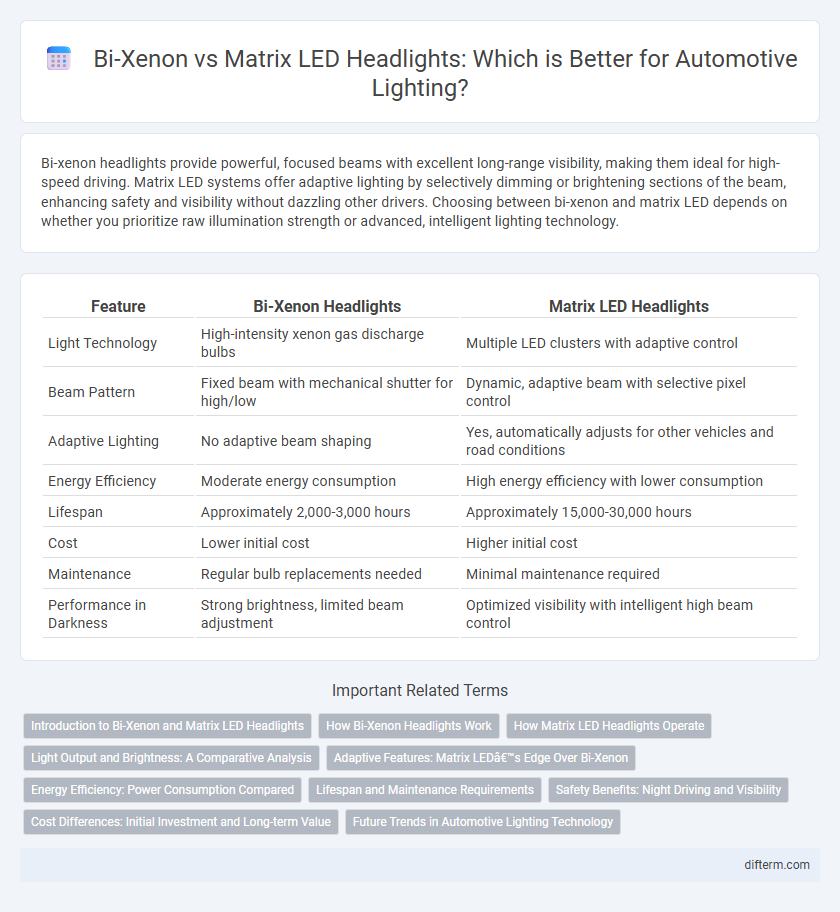Bi-xenon headlights provide powerful, focused beams with excellent long-range visibility, making them ideal for high-speed driving. Matrix LED systems offer adaptive lighting by selectively dimming or brightening sections of the beam, enhancing safety and visibility without dazzling other drivers. Choosing between bi-xenon and matrix LED depends on whether you prioritize raw illumination strength or advanced, intelligent lighting technology.
Table of Comparison
| Feature | Bi-Xenon Headlights | Matrix LED Headlights |
|---|---|---|
| Light Technology | High-intensity xenon gas discharge bulbs | Multiple LED clusters with adaptive control |
| Beam Pattern | Fixed beam with mechanical shutter for high/low | Dynamic, adaptive beam with selective pixel control |
| Adaptive Lighting | No adaptive beam shaping | Yes, automatically adjusts for other vehicles and road conditions |
| Energy Efficiency | Moderate energy consumption | High energy efficiency with lower consumption |
| Lifespan | Approximately 2,000-3,000 hours | Approximately 15,000-30,000 hours |
| Cost | Lower initial cost | Higher initial cost |
| Maintenance | Regular bulb replacements needed | Minimal maintenance required |
| Performance in Darkness | Strong brightness, limited beam adjustment | Optimized visibility with intelligent high beam control |
Introduction to Bi-Xenon and Matrix LED Headlights
Bi-xenon headlights utilize xenon gas-discharge bulbs to provide intense, bright illumination with a characteristic bluish tint, offering improved visibility over traditional halogen lamps. Matrix LED headlights consist of multiple adaptive LED segments that can automatically adjust light distribution, enhancing road illumination while reducing glare for oncoming traffic. The advanced technology in matrix LED allows precise control of light beams, improving safety and driving comfort compared to the fixed beam pattern of bi-xenon systems.
How Bi-Xenon Headlights Work
Bi-xenon headlights work by utilizing a single xenon bulb with a mechanical shutter to switch between high and low beams, providing bright and efficient illumination. The xenon gas ignites to produce a bright white light, which is reflected and focused by projector lenses to enhance nighttime visibility. Unlike matrix LED systems, bi-xenon headlights offer a simpler design but lack adaptive lighting capabilities such as selective beam shaping for oncoming traffic.
How Matrix LED Headlights Operate
Matrix LED headlights operate using numerous tiny LED segments that individually adjust their brightness and shading to optimize road illumination while avoiding glare. These segments work in real-time with sensors and cameras to detect oncoming traffic and street conditions, selectively dimming certain LEDs to maintain visibility without blinding other drivers. This adaptive lighting technology provides superior precision compared to bi-xenon headlights, enhancing safety and driving comfort.
Light Output and Brightness: A Comparative Analysis
Bi-xenon headlights produce a bright, focused beam with high intensity reaching up to 3,000 lumens, ideal for clear long-distance visibility in automotive lighting. Matrix LED systems deliver superior light output with adaptive beam patterns, achieving brightness levels around 5,000 lumens while minimizing glare for oncoming traffic. Advanced matrix LED technology also offers enhanced uniformity and dynamic brightness control, improving overall driving safety compared to conventional bi-xenon headlights.
Adaptive Features: Matrix LED’s Edge Over Bi-Xenon
Matrix LED headlights provide superior adaptive features compared to bi-xenon by using individually controllable LED segments to optimize light distribution. This technology enables precise glare-free high-beam control, enhancing nighttime visibility while preventing dazzling oncoming traffic. Bi-xenon systems, although powerful, lack the dynamic adaptability and sharp beam pattern customization that Matrix LEDs deliver for improved safety and driving comfort.
Energy Efficiency: Power Consumption Compared
Bi-xenon headlights typically consume around 35 watts per bulb, offering a moderate level of power efficiency for automotive lighting. Matrix LED systems, leveraging numerous small LEDs, use approximately 15 to 25 watts per unit while delivering superior brightness and adaptive beam control. This lower power consumption combined with enhanced performance makes matrix LED technology more energy-efficient compared to traditional bi-xenon setups.
Lifespan and Maintenance Requirements
Bi-xenon headlights typically offer a lifespan of around 2,000 to 3,000 hours, requiring occasional bulb replacements that can be both time-consuming and costly. Matrix LED systems boast an extended lifespan exceeding 20,000 hours, significantly reducing maintenance frequency due to the durable semiconductor technology. The advanced design of matrix LEDs also minimizes performance degradation over time, resulting in lower total ownership costs compared to bi-xenon units.
Safety Benefits: Night Driving and Visibility
Bi-xenon headlights provide intense, focused illumination that significantly improves night driving visibility, reducing eye strain and enhancing reaction times to road hazards. Matrix LED systems offer dynamic light distribution by selectively dimming sections of the beam to prevent glare for oncoming traffic while maintaining optimal road illumination, increasing overall safety in complex driving conditions. Advanced sensor integration in matrix LED technology ensures adaptive lighting tailored to speed, weather, and traffic, further improving nighttime driving safety compared to static bi-xenon systems.
Cost Differences: Initial Investment and Long-term Value
Bi-xenon headlights typically offer a lower initial investment compared to matrix LED systems, with costs often ranging from $500 to $1,200 for installation. Matrix LED technology, while more expensive upfront--frequently exceeding $1,500--delivers superior energy efficiency, adaptive beam control, and longer lifespan, which can reduce maintenance expenses over time. Considering total cost of ownership, matrix LEDs provide enhanced long-term value through improved safety features and lower operational costs despite the higher initial price.
Future Trends in Automotive Lighting Technology
Bi-xenon headlights offer strong illumination with focused beams, but matrix LED technology provides adaptive lighting by selectively controlling individual LEDs for enhanced safety and energy efficiency. Future automotive lighting trends emphasize smart, connected systems integrating matrix LEDs with sensors and AI to optimize visibility in various driving conditions and reduce glare for oncoming traffic. Innovations include dynamic beam shaping, customizable lighting signatures, and increased integration with autonomous driving systems for improved road safety.
bi-xenon vs matrix LED Infographic

 difterm.com
difterm.com